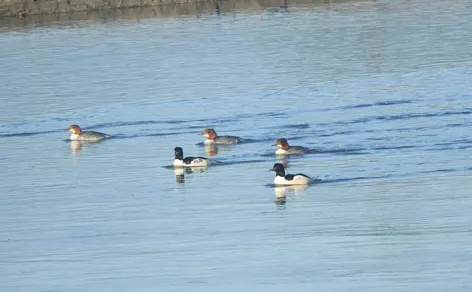[ Tasang Taga ]
With the onset of winter, migratory birds, including the ruddy shelduck (Tadorna ferruginea), the great cormorant (Phalacrocorax carbo), the common merganser, the Indian skimmer, the white-winged wood duck, and many other colourful water birds have started flocking to the water bodies of the Daying Ering Wildlife Sanctuary (DEWS) in East Siang district since the second week of November, attracting special attention of the wildlife officials and nature lovers.
Though wildlife officials used to witness the arrival of the avian visitors to the area during December, January or early February each year, the winged guests have arrived early this year. Several flocks of birds, most of which have migrated from Siberia and Mongolia, were seen in various water bodies of the sanctuary from the second week of November.
Apart from migratory birds, a large number of grassland-dependent bird species, such as the swamp francolin (Francolinus gularis), the Jerdon’s babbler (Chryssoma altirostre), the swamp prinia, and the black-breasted parrotbill (Paradoxornis flavirostris) are also found in the sanctuary’s grassland.
As per record, over 150 bird species have been reported, including endangered birds like the Bengal florican (Houbaropsis bengalensis). The most recent estimate is of 60-70 pairs, as per the BNHS.
The DEWS is located near Pasighat, the headquarters of East Siang district, and covers an area of approximately 190 square kms. It is sandwiched between the Siang and the Sibya rivers in East Siang district. The sanctuary lies in the low-altitude floodplains on the boundary of Arunachal Pradesh and Assam.
The sanctuary has extensive floodplain grasslands (about 80 percent). Saccharum spontaneum, S arundinaceum and Neyraudia reynaudina are the main grass species, and sedges such as cyperus sp also occur. Other habitat types include riverine forests with tree species such as Terminalia myriocarpa, Bombax ceiba and Dillenia indica.
The sanctuary is known for its rich biodiversity and has been regaining its past glory in the last four years, thanks to the intensified round-the-clock patrolling and intensive action against hunters and poachers, including timber mafias, by the present sanctuary authority.
The sanctuary authority has a limited number of staffers, most of whom are in casual/contingency positions and have been serving at the sanctuary for the last 30 years, besides other recently recruited ones.
In our committed effort to secure the sanctuary from hunting and other illegal activities to revive the sanctuary in the real sense, we have seized more than 20 guns, and around 30 hunters/poachers have been arrested in the last four years.
In the process of protecting the sanctuary in the true sense, some serious actions were needed, despite public opposition and reaction (mostly from those who sympathise with hunters and support hunting), but we did it even by banning fishing activities of the public and fishermen engaged by local fish mahaldars deep inside the sanctuary, as many people were found laying cable traps and even hunting on the pretext of fishing in the sanctuary’s rivers in the past.
Apart from intensified patrolling, our field staff and officials, and the Eco-Development Committee members, are constantly mobilising the people of the fringe areas to protect the flora and fauna of this riverine island sanctuary, which is necessary for maintaining the ecology of the region for larger human interest. (Tasang Taga is DFO, DEWS, Pasighat.)


